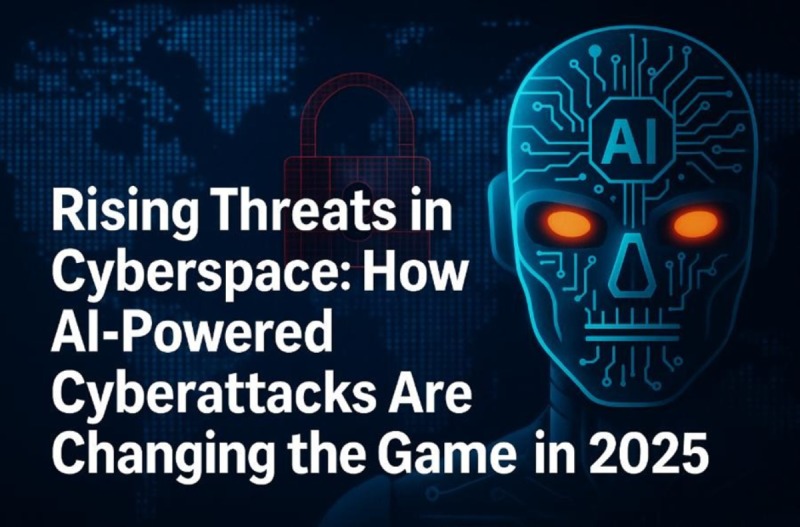Tech
Rising Threats in Cyberspace: How AI-Powered Cyberattacks Are Changing the Game in 2025

As we reach mid-2025, the cyber threat landscape has undergone a dramatic transformation. Today, artificial intelligence—once predominantly seen as a force for defense—is now the most potent weapon in the hands of cybercriminals. AI-powered cyberattacks are scaling in frequency, sophistication, and scope, disrupting individuals, industries, and even national security on a global stage.
Automation & Scale: 36,000 Scans a Second
Fortinet’s 2025 Global Threat Landscape Report reveals a staggering 16.7% year-on-year increase in automated scanning, now reaching approximately 36,000 scans per second—a reflection of just how powerful AI-driven automation has become. In addition, a 500% surge in compromised-system logs—amounting to 1.7 billion stolen credentials—is fueling a 42% spike in credential-based attacks.
Sophisticated Social Engineering & Deepfakes
Phishing—the cyberattack that once relied on human error—is now amplified by AI. Deepfake audio and video are being used in hyper-realistic scams. The United Kingdom’s NCSC and the
U.S. NIST identifies this as a top security threat. In APAC, as well as in India, the use of AI in spear-phishing has surged, successfully mimicking voices and emails from trusted sources.
An Australian tax-scam case highlights a 300% year-over-year spike in AI-generated phishing, where scammers combine deepfake voices, personalized SMS, and bogus help desks to extract data.
Financial Industry Under Siege
A recent Accenture poll found that 80% of bank cybersecurity executives admit they can’t keep pace with AI-powered attacks, despite spending hundreds of millions on defense. Daily AI-powered attacks are now anticipated by 93% of security leaders, with phishing, ransomware, DDoS, and APTs all becoming AI-enhanced threats.
Critical Infrastructure at Risk
State-sponsored and criminal actors are now using AI to target national infrastructure. Trustwave warns of AI-driven ransomware and disruptions in sectors like energy, water, transport, and healthcare. Cyber-warfare is also evolving—for example, Iran–Israel tensions have produced a 700% surge in Iranian cyberattacks, including DDoS and disinformation campaigns.
The UN has also sounded the alarm: terrorists could repurpose AI-enabled vehicles, drones, and city systems into autonomous weapons. A major international report recommends urgent action to prevent “slaughterbot”-style scenarios within the next 5–10 years.
LLM-Based Autonomous Attack Agents
Cutting-edge academic research points to LLM-based systems (dubbed “Cyber Agents”) that can autonomously scout networks, craft exploits, coordinate multi-stage attacks, and operate with minimal human oversight. This marks an evolutionary leap in AI weaponization.
Defensive AI & Regulatory Response
It isn’t all bleak. Tech giants are fighting back. Google, for example, has launched enhancements to Safe Browsing using its Gemini AI model to combat phishing scams, crashbytes.com. In India, Google’s Safety Charter aims to prevent over ₹20,000 crore in losses (roughly USD 2.4 billion) from UPI fraud through AI-enhanced defenses
AI has become a double-edged sword in cybersecurity—powering both defense and offense with equal intensity. As cybercriminals deploy autonomous agents, deepfake phishing, and infrastructure-targeting malware, defenders must match their speed and scale with vigilant AI-backed monitoring, advanced architectures, and strong regulation. In 2025, the key to safeguarding cyberspace lies not in ignoring these dangers, but in harnessing AI’s potential to build resilient, adaptive defenses—and ensuring no one is left behind.
Dr. Sukhpreet Singh
Assistant Professor
Chandigarh University
-

 Lifestyle4 weeks ago
Lifestyle4 weeks agoBob Gerace Discusses Coaching Themes: Confession, Reconciliation, Communication, Intimacy, and Fatherhood
-

 Education3 weeks ago
Education3 weeks agoAn Exclusive Interview With Holly Gold: The Heart and Vision Behind The Little Schools
-

 Travel4 weeks ago
Travel4 weeks ago8000 Voices, One Vibe — Ludhiana Sang Every Word with Talwiinder at Bangr Arena
-

 Business3 weeks ago
Business3 weeks agoCorporate Event Catering in Manchester: What Businesses Need to Know (and why Manchester sets the bar)
-
Tech4 weeks ago
Harrington Quality Management System (HQMS): Flagship Platform of Harrington Group International
-

 Business3 weeks ago
Business3 weeks agoCorporate Christmas Gifting Makes a Big Comeback
-

 Apps3 weeks ago
Apps3 weeks agoCanva Launches AI-Powered Design Model and New Creative Features
-

 Travel3 weeks ago
Travel3 weeks agoExploring Europe’s Most Photogenic Cities for Your Next Trip




















